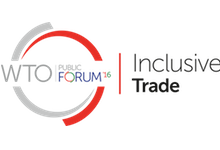Digital customs for improved border management and e-commerce opportunities
28 Sep 2016 15:30h - 17:00h
Event report
[Read more session reports and live updates from the 2016 WTO Public Forum.]
This session, organised by the World Customs Organization (WCO) and the American Association of Exporters and Importers (AAEI), aimed at discussing how customs and other border agencies are responding to the ever-growing challenges of e-commerce and other changes in trade patterns. Kevin Willis, Director of Global Trade Services at Amazon, highlighted differences between traditional commerce and e-commerce. The latter is mostly based on single, low-value shipments, consisting of small parcels which are sent to millions of individual consumers across the globe. Therefore, customs agencies are starting to deal with individual customers and not importers.
Technical processes in e-commerce platforms are designed to minimise a customer’s frustration; they need to offer simplification, innovation, consistency, and a smooth user experience. Nevertheless, there is considerable complexity when it comes to the rules that companies need to observe in the international space. The authorities should protect citizens, but many national regulations were designed for bricks-and-mortar businesses. Amazon and other big players can deal with complexity, but for small and medium enterprises (SMEs), there are challenges when it comes to compliance. The principle of simplification should apply to rules as well. Companies do not want special rules, they want clear rules.
Sun Xiangyang, Minister Counsellor at the Mission of China to the EU, presented the Chinese experience. He started by highlighting some positive aspects of e-commerce. Microenterprises and SMEs are abundant in China. E-commerce provides them with opportunities, stimulating domestic consumption. Another positive effect is job creation, including in the sectors of logistics and delivery. For customs control, e-commerce generates an opportunity: it creates valuable data. Information on what someone buys, how it was paid for, and how it was delivered are all available on the Internet. This creates big data, which changes the way customs exercises control. Previously there was a need for physical inspection. Now customs do not need to inspect the container, they inspect information on the owner of the container. If the owner has a record of being compliant,, there is less chance of smuggling.
But e-commerce also brings challenges. Traditionally, everything crossing the Chinese border was divided into cargo or personal belongings. For cargo, there are trade restrictions. This applies, for instance, to pharmaceutical products, which need to be tested and approved before being released. However, personal belongings do not require any special measure. Because e-commerce is based on small parcels, trade restrictions have been duly avoided. China developed a customs plan that, among other things, tries to tackle this problem. It added a third category to the cross border flow: cross-border e-commerce retail. Information on the online order, payment, and delivery are crossed-referenced to find
inconsistencies. In addition, cross-border e-commerce retail has a clear tax policy. Customs duty has been reduced to zero and there has been an 80% reduction of VAT.
The potential benefits of e-commerce for all sectors was highlighted by Norm Schenk, Vice-President of Global Customs Policy & Public Affairs, UPS Supply Chain Solutions, Inc. SMEs and least developing countries should be aware that it only takes 22 new international packets to create and support a new job. Delivery companies can also benefit, especially if they seize the opportunity to provide new and creative solutions, tailoring their services to the needs of the consumer. For instance, the package could ‘notify’ the consumer that the delivery will happen soon and, if the receiver will not be home, they could change the place of delivery. Technology can alleviate customs’ concerns and be used to ensure compliance with national laws. Schenk mentioned that a global alliance for trade facilitation was launched by Australia, Canada, Germany, and the United States, dedicated to examining WTO agreements with the help of companies and to suggesting improvements. For example, the payment of customs duties and VAT by SMEs is stifling business. Procedures for returning products that did not meet the expectations of the consumer should be simplified.
Ana Hinojosa, Director of Compliance and Facilitation at the WCO mentioned the creation of a working group on e-commerce, divided into four subgroups: trade facilitation, security, revenue collection, and measurement and analysis. The groups are diverse in composition and the co-chairs come from different sectors to ensure diversity.
by Marília Maciel
Related topics
Related event

